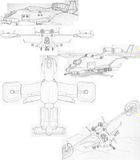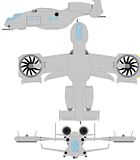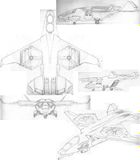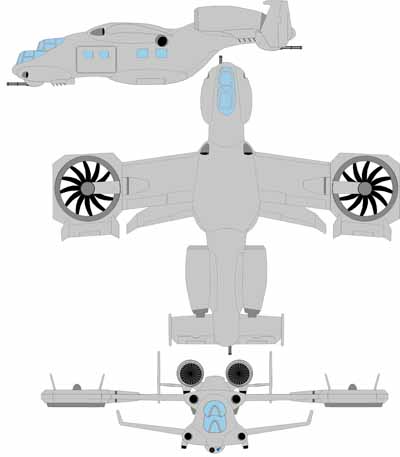Greetings!
Welcome to Scifi-Meshes.com! Click one of these buttons to join in on the fun.
Quick Links
2DNear-future VTOL transport/gunships
So back when I was but a wee lad, maybe a decade ago now, I built an aircraft out of Legos that I was quite proud of. It was a large VTOL aircraft that used a combination of ducted fans and jets for propulsion, and I envisioned it as a replacement for the V-22 Osprey (which is funny since back then the Osprey was still a prototype), except more capable, with enough armament to serve as a gunship, the same carrying capability, and large jets that made it much faster in conventional flight. It looked like a mix between the Mi-24, V-22, and A-10.
Recently I decided I'd really like to rebuild that aircraft, but as a paper model instead of with Legos (especially since I don't have the Legos anymore). However, after sketching the design out, and putting it in photoshop, I realized it was too large, complex, ungainly, and ugly to be an American aircraft, as much as I liked the design. Instead, I realized the design looked far more like something you would expect Russia to develop. So I decided to make it Russian in origin, but at the same time, still felt there needed to be an American equivalent of sorts. What I ended up coming up with was a much smaller aircraft with very different specifications. Where the Russian VTOL featured 6 engines, the American VTOL has only 2. Where the Russian design was large and powerful looking, the American design was looked small and specialized. The Russian design was very armor laden, the American design was less protected, but featured stealth aspects, and was faster.
Anyway, I sketched both out, and scanned them. I've mostly solidified the Russian design in Photoshop, but the American is still just sketch. Regardless, I figured I'd share.


This is the Russian transport. A joint project between Mil and Antonov, the MA-4 Voronkov (NATO reporting name: Vanguard (under the new VTOL category instead of an H name for the helicopter category)), is a very complex VTOL transport that also operates as a gunship, similar to the old Mi-24 helicopter. The MA-4 was designed as a response to the V-22 Osprey, but expected to be (as is often the objective for Russian designs) better in all aspects, including speed, armor, firepower, capacity, and survivability.
The MA-4 employs 4 main powerplants and 2 secondary engines; two Klimov VK-2500 engines that drive the large ducted fans one its wingtips, two TRD R-237 turbojets on the rear fuselage above and forward of the tail, and two optional R-95-400 turbofan engines in the nose to aid VTOL in heavier or higher capacity variants of the MA-4. The design places the two TRD R-237 engines high to prevent them from ingesting debris kicked up by the two large ducted fans, which produce the majority of lift during vertical takeoffs and landings. To aid in control and power, the turbojets also have the ability to vector thrust downward, with the two smaller nose turbofans.

And this is the American transport, the Boeing V-34 Accipiter. Designed as a next generation VTOL aircraft to first supplement, the V-22 Osprey, it ended up slowly phasing the V-22 out of service. The V-34 has two main powerplants, two General Electric/Rolls-Royce F143 turbofans. The engines produce propulsion both as jets, and by powering the two ducted fans mounted on the wings, via a transfer shaft connected to both engines' turbines, that in turn connects to two counter-rotating axles leading to each fan (essentially acting as turboprops). The design of the transfer mechanism makes it possible to power both fans even after the failure of one engine. The aircraft features low-observability design that includes composite materials for absorbing radar. It is armed with a forward gatling gun, and includes two internal stores behind the cockpit for missiles. The Accipter's turbofans also include vectored thrust capability, mostly designed to aid in short landing or takeoff. The design features a Pelikan tail and winglets.
Both of them can take off and land vertically or as conventional aircraft with very short runway requirements. Naturally, the MA-4, despite being much larger, costs slightly more than half the price of the V-34 to produce, however the Russians have only been able to order 200 of them, and are trying to sell contracts for the MA-4 to other countries. Boeing has built 340 V-34s, split between the Marines (218, Navy (72, and Air Force (50). Because of its larger, more powerful engines, and swept wings, the V-34 has a higher top speed, though it is still subsonic. The V-34's engines are actually a non-afterburning modification of an engine developed to refit the F-22 Raptor, making the V-34 quite powerful, with thrust vectoring that makes the V-34 remarkably nimble in conventional flight, earning it the nickname "fighter transport". The V-34 is reasonably capable in air-to-air combat, and can carry the AIM-9 or AIM-7 missile in it's forward ordnance bay.
While MA-4 development was started only one month earlier than the V-34, it's development was significantly shorter, due to the more conventional nature of the airframe, and no need to develop a new transfer system for the engines, mostly using parts and technology already available. The MA-4 prototype flew six years earlier than the V-34, and entered service seven years earlier.

Recently I decided I'd really like to rebuild that aircraft, but as a paper model instead of with Legos (especially since I don't have the Legos anymore). However, after sketching the design out, and putting it in photoshop, I realized it was too large, complex, ungainly, and ugly to be an American aircraft, as much as I liked the design. Instead, I realized the design looked far more like something you would expect Russia to develop. So I decided to make it Russian in origin, but at the same time, still felt there needed to be an American equivalent of sorts. What I ended up coming up with was a much smaller aircraft with very different specifications. Where the Russian VTOL featured 6 engines, the American VTOL has only 2. Where the Russian design was large and powerful looking, the American design was looked small and specialized. The Russian design was very armor laden, the American design was less protected, but featured stealth aspects, and was faster.
Anyway, I sketched both out, and scanned them. I've mostly solidified the Russian design in Photoshop, but the American is still just sketch. Regardless, I figured I'd share.


This is the Russian transport. A joint project between Mil and Antonov, the MA-4 Voronkov (NATO reporting name: Vanguard (under the new VTOL category instead of an H name for the helicopter category)), is a very complex VTOL transport that also operates as a gunship, similar to the old Mi-24 helicopter. The MA-4 was designed as a response to the V-22 Osprey, but expected to be (as is often the objective for Russian designs) better in all aspects, including speed, armor, firepower, capacity, and survivability.
The MA-4 employs 4 main powerplants and 2 secondary engines; two Klimov VK-2500 engines that drive the large ducted fans one its wingtips, two TRD R-237 turbojets on the rear fuselage above and forward of the tail, and two optional R-95-400 turbofan engines in the nose to aid VTOL in heavier or higher capacity variants of the MA-4. The design places the two TRD R-237 engines high to prevent them from ingesting debris kicked up by the two large ducted fans, which produce the majority of lift during vertical takeoffs and landings. To aid in control and power, the turbojets also have the ability to vector thrust downward, with the two smaller nose turbofans.

And this is the American transport, the Boeing V-34 Accipiter. Designed as a next generation VTOL aircraft to first supplement, the V-22 Osprey, it ended up slowly phasing the V-22 out of service. The V-34 has two main powerplants, two General Electric/Rolls-Royce F143 turbofans. The engines produce propulsion both as jets, and by powering the two ducted fans mounted on the wings, via a transfer shaft connected to both engines' turbines, that in turn connects to two counter-rotating axles leading to each fan (essentially acting as turboprops). The design of the transfer mechanism makes it possible to power both fans even after the failure of one engine. The aircraft features low-observability design that includes composite materials for absorbing radar. It is armed with a forward gatling gun, and includes two internal stores behind the cockpit for missiles. The Accipter's turbofans also include vectored thrust capability, mostly designed to aid in short landing or takeoff. The design features a Pelikan tail and winglets.
Both of them can take off and land vertically or as conventional aircraft with very short runway requirements. Naturally, the MA-4, despite being much larger, costs slightly more than half the price of the V-34 to produce, however the Russians have only been able to order 200 of them, and are trying to sell contracts for the MA-4 to other countries. Boeing has built 340 V-34s, split between the Marines (218, Navy (72, and Air Force (50). Because of its larger, more powerful engines, and swept wings, the V-34 has a higher top speed, though it is still subsonic. The V-34's engines are actually a non-afterburning modification of an engine developed to refit the F-22 Raptor, making the V-34 quite powerful, with thrust vectoring that makes the V-34 remarkably nimble in conventional flight, earning it the nickname "fighter transport". The V-34 is reasonably capable in air-to-air combat, and can carry the AIM-9 or AIM-7 missile in it's forward ordnance bay.
While MA-4 development was started only one month earlier than the V-34, it's development was significantly shorter, due to the more conventional nature of the airframe, and no need to develop a new transfer system for the engines, mostly using parts and technology already available. The MA-4 prototype flew six years earlier than the V-34, and entered service seven years earlier.

Post edited by Paragon on
Tagged:
Additional credits
- Icons from Font-Awesome
- Additional icons by Mickael Bonfill
- Banner background from Toptal Subtle Patterns
© Scifi-Meshes.com 2001-2024
Posts
Oh, and it case it wasn't obvious, the fans DO pivot on both aircraft for both pitch and yaw control, as well as roll via differential thrust when in VTOL mode. As you can see, the V-34 has doors that close to cover the fans during normal flight to increase it's stealth.
1) On the V-34 you are not showing what happens to the doors that cover the fans in cruise mode, when in lift configuration. This something that has vexed real lift/cruise fan design for a long time. Having the multi-door configuration that you seem to have disrupts airflow a lot in and out and makes them less efficient. Having single giant slap doors (ala the F-35) has other issues, namely giant slab doors that are heavy, ackward and in your case would impede ground exit from the side doors. If you have figure a way to integrate them I would say to try something similar to the what hte X-35 had, a pair of smaller doors that open to the side, but you might need to keep the doors you have now on the bottom due to clearance issues.
2) Again on the V-34, the rear ramp looked better in the drawings, visually and areodynamically. Cargo space wise the CAD drawing looks better, it's a balance to strike, but I would say extend the tail a few more feet to keep the cargo capacity the same and bring back the less severe slope.
3) Last one on the V-34. Ditch the missile bay, or just put in A-G ordnance, maybe a single sidewinder for defense. Integrating a radar guideded weapon requires a lot more hardware then you might want to take on, especially and AIM-7 as they are being phased out in favor of the AIM-120. In fact I don't think anyone even fields AIM-7s anymore in the US.
4) On the MA-4, really love this one, and while the lower wings look bad ass, if their entire purpose is for ordnance carry, which it looks like, ditch them. You have a perfectly suitable high wing for that, and having them adds too much weight, and talk to ordnance handlers, they hate low to the ground wings like that as it makes loading an absolute pain.
5) MA-4 again, I love how the thing looks like the love child of an A-10 and a Hind, but it will be slower than the V-34, it's just not as clean aerodynamically and it looks very heavy, especially with it lugging around those extra engines.
6) Last one, again on the MA-4, duct your exhaust from the turboprops out the top middle, between the engines, it will mask them better thermally from the ground (where most of your threats will be), and it should channel it between the upper engines to keep clean air going to them.
Hope the comments are helpful and again I love these designs, can't wait to see more
I did decide to extend the back as you suggested as well, as well as the nose. As for the missile bay, I guess I forgot to mention it before, but they are primarily AGM and rockets. I wanted to include two AAMs for self defense, I just forgot how old the AIM-7 was. Sidewinders are fine, but with new military aircraft taking steps to minimize heat signatures, I figured radar would work better.
Anyway, here are the changes:
Oh, as you can see, I added a bottom view too. Two things to explain about the bottom. First, the heat absorbing troughs in the back are not for two extra engines, they're part of the thrust vectoring system. It's hard to explain without a good visual aid. Also, the rear door is inward opening to prevent the need for a locking mechanism (since the interior is obviously pressurized), and they fold over like closet doors. They do take up a small amount of internal space to open and close, but the design is supposed to try and minimize that.
Meanwhile on the MA-4;
- Like I said, I built it out of legos when I was a kid, so yeah, the lower wings were just to look good. I'd like to keep them because I like the way they look, but haven't found a great reason yet.
- The MA-4 is definitely slower than the V-34. I didn't design them to be exact counterparts, and I would expect them to fill slightly different roles. The MA-4 does have a larger capacity (maybe the lower wings could be useful for extra lift), and was designed to be a more blunt, brute force approach. I would expect the MA-4 to utilize its ground attack capabilities better and more often than the V-34.
- Good idea.
Question: Do you think aircraft like these would have trim tabs? I included them on the MA-4, but not the V-34. The V-22 Osprey doesn't seem to have them.
come to think of it, didn't the U.S. Army experiment with a similar craft during the height of the Cold War? i seem to recall that it was about the size of a small fighter jet but was designed for search and rescue of all things. can't seem to remember it's name for the life of me though.
Other than that I like all the updates, I would just double the gap between the wing and tail, extending the tail back to give better ground clearance for your troops coming out the back, you don't want them running straight into a hot exhaust. Does a ramp extend out the back or is it just a jump down?
As for trim tabs, only if it is fully manual, ie not fly by wire. FBW aircraft do not have trim tabs as the computer controls that and keeps it level. But I would say they should both be FBW so no need for trim tabs.
Not true at all. Almost all aircraft use trim tabs or servo tabs for fine tuning attitude including fly-by-wire aircraft. Autoflight systems use trim, tabs, spring tabs and servo tabs to "fly" a control surface into a position as well as pilots when hand flying. A FBW distinction only refers to how the input to those devices is delivered, digital vs. mechanical.
found it. the XV-5A Vertifan (http://en.wikipedia.org/wiki/Ryan_XV-5_Vertifan ). it was originally proposed as an armed escort for helicopters, with a SAR version proposed but never developed. could most likely have gone into production if i'm understanding things correctly.
for VSTOL operations, it had two large fans situated in either wing, which were covered by doors when in forward flight and would open for hovering operations (don't know how exactly they were utilized though. a small auxiliary fan in the nose was used for pitch and trim control. this was accomplished via moveable louvers above the intake to direct airflow. for forward flight, two J85 turbojets were placed on top of the fuselage. the exhaust from said engines could be diverted into the fans for hovering or redirected out the tailpipes for forward flight.
don't known if this pertains to your debate, but the Vertifan used a large horizontal T-tail which was programmed to adjust pitch trim during transition from fan-supported flight to wing-supported flight. elevators provided longitudinal control during conventional flight, although override of the program and manual adjustment to the elevator was optional.
NOTE: i'm not an expert on this. just writing down what is written in a book i have
1) Separate cockpits for pilot and navigator/weapon operator. Originaly, Mi-24 used single cockpit for both of them (like on american assault copters. You can google for Mi-24 prototype). However, such design proove to be dangerous, since single hit could disable or kill both members of the crew and crash the helicopter. That`s where separate cockpit design originates. However, in your VTOL, despite being the separate "bubbles", the internal space of the cockpits overlap. This means, that all the survivability idea goes to waste. You may choose to move upper cockpit a bit further backward, to have some space between them, like on actual Mi-24.
2) Next point is the huge number of lifting surfaces, a.k.a. "wings". Yes, Mi-24 is known for it`s ability to achieve about 25% of lifting force from it`s wings, however, you choose to have 3 pairs of wings, and that is a sure overkill. That`s basicly takes us to a problem, that led the biplanes into extinction. You know, each wing not only produce lifting force, bud also, creates drag, that slows the aircraft, making it less efficient. IMHO, you can scrap the lower wings alltogather, and think about mono-tail design - it produce less drag. Maybe even with build in propeller, for maneuvering while in hover mode, like on "komanche" or Ka-60. Using tail rotor, can make the wing rotor`s actuators less complex. Also, the wing that holds the lift rotors is a bit too thin. You can try to make it thicker, where it closer to the hull. This wing at the very least, holds the transmission from engines (in the back of the craft) and may hold fuel tanks. Also - this wing suites best for missile hardpoint placement.
3) Thrusters. You choose to for separate thrusters for "plane mode" and "VTOL mode". However, there is a possibility to combine them. Helecopter runs on turboshaft engines, however, you CAN use gas turbine engine instead! Yes, it is a ski-fi approach, but roughly, the difference between them is the % of thrust, used to rotate shaft. Theoreticaly, you can make gas turbine engine that can be switched to turboshaft mode as needed. Any way, the intakes on your turboshaft engines are too small for such monster.
4) Lift rotors. That`s just my opinion, but it seens that impellers are too small to lift such craft. However, I can be wrong, of course.